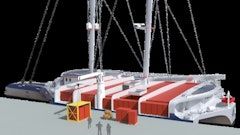As any PRW or refrigerated carrier will tell you, shipping perishables is not for wimps. The delicate nature of produce, meats and frozen foods makes it a challenge to deliver the products in their ideal state.
Add to the equation human error, equipment failure and sometimes less-than-perfect supply chain partners, and you’ve got your work cut out for you.
“Lots of things can happen along the way in the supply chain,” says Charlie Bronson, senior vice president of sales for Walnut Creek, CA-based PLM. “The challenge is trying to maintain consistent temperatures throughout all the ‘touch’ points of a product’s life.”
A variety of supply chain partners can impact the quality of products. “The origin of the products could be the field, the processing plant or the DC,” says Bronson. “You need to get the products at the right temperature from the initial touch point and then maintain that temperature throughout the supply chain.”
That’s tougher than it might seem—a variety of situations can take place along the way. For instance, the loading docks might not be refrigerated at a DC; a truck may not be at the right temperature; or product may sit on outgoing docks too long if a truck is late. “People still make the mistake of thinking that you can take the heat out of a product during the transportation leg of the supply chain,” says Bronson. “That’s not the case—you can only maintain the temperature that you were given.”
But that’s not all. Carrier capacity can also impact how successful you are at shipping and delivering perishables in the right condition. Jeff Potts, vice president at Lean Logistics, based in Holland, MI, says that companies are constantly challenged by costs brought on by a variety of factors. “You have retailers who are demanding smaller orders more often, combined with the new hours of service rules which have reduced the number of hours that drivers can drive,” he says. “The net effect is that companies have to ensure that loads will go out in a timely fashion without paying the premium rate.”
The bottom line is that you need to have best practices in place to ensure that the perishables you handle make it to their destination in the best shape possible. On the pages that follow, we’ve compiled a list of the practices that can help you get the job done:
1. Scheduling: Perhaps the best step you can take when shipping delicate perishables is to get your carrier scheduling in order. “There used to be an adversarial relationship between carriers and their clients,” says PLM’s Bronson. “But now you see more cooperation between the two parties to reduce pick-up and delivery times.”
Andy Janson, vice president of business development and logistics for Hanson Logistics in St. Joseph, MI, has made this a priority for his company. Originally a cold storage company, Hanson has recently evolved into a full third-party logistics provider. “We understand how important it is to focus on scheduling so that orders are selected in a timely fashion,” he says.
Janson says that proper scheduling leads to several other equally important activities falling into place. “You need to arrange scheduling so that orders are picked at the right time, but not too far in advance,” he says. “Staging has to be at the right temperature, and proper scheduling helps ensure that.”
For instance, at Hanson there are three docks that are consistently kept at the right temperature for ice cream. Proper scheduling ensures that those docks are available whenever ice cream needs to be loaded or unloaded.
Bronson says that often carriers and clients work out delivery windows ranging from 15 to 30 minutes to ensure product integrity. “These improvements were needed—there was a time where trucks might have to wait for hours for pick up,” he says.
Hanson has put appointment scheduling software into place to help it optimize scheduling. “This has been a big advantage for our carriers,” says Janson. “We make our appointment schedule open to them online so that we can work with them to schedule shipping and receiving accordingly.”
The company also makes sure that all required shipping documentation is prepared in advance to minimize the loading/unloading process. “That way product doesn’t sit in the wrong temperature zone while we finish up,” says Janson.
2. Proper loading/unloading practices: Part of Hanson’s loading checklist includes pre-cooling the trailers that will carry perishables. This is an important practice, says Jack Ampuja, president of Buffalo, NY-based Supply Chain Optimizers.
“You have to get the temperatures down in trucks before the loading process begins,” he says. “This is not a five-minute project.”
On the unloading side, it is important to turn the reefer off before opening the truck doors, says Ampuja. “Too often, the guys on the dock ask the driver to keep the unit going,” he says. “There’s a misconception that cold air sinks. When the door is open, the cold air exits the trailer at the back end and sucks the warm air in from the top.”
Ampuja, whose former position was at Rich Foods, says that this practice isn’t intuitive. For that reason, he says, when he was with Rich, the company placed signs on the backs of trailers to remind drivers and dock workers to turn the reefer units off during loading/unloading.
It’s also important, says PLM’s Bronson, that drivers verify that product is at the right temperature at the point of loading. This can be a challenge, however, with high driver turnover. “Most companies equip drivers with a cheat sheet that helps them know the right temperatures for a variety of products,” he says. “Drivers have to have guidelines on the products they’re carrying and what their temperature should be.”
3. Use refrigerated docks: “Every DC should have refrigerated docks,” says Bronson. Amazingly, though, there are plenty out there that still don’t have this basic technology today.
Most refrigerated docks are maintained at between 35 and 40 degrees, according to Janson. “Even with refrigerated docks, you need to move these products as quickly as possible so that they’re sitting on the docks for the minimal amount of time,” he says.
Ampuja of Supply Chain Optimizers seconds this advice. “You want to make a quick transfer,” he says. “But refrigerated docks are a must—you can’t take food from a 35-degree warehouse and set it on a 65-degree dock.”
If necessary, he adds, temporarily store the products in a cooler before loading them onto the docks to further minimize variations in temperature.
4. Use proper loading and packaging: When produce is loaded onto a truck, it is essential that it is placed loosely enough to allow for proper air circulation. “If the products are packed too tight, they’re not going to get the necessary air circulation,” says Ampuja. “Air chutes on the truck can help improve the situation by letting the air run through to the back of the truck.”
Proper packaging also plays an important role. The Herbal Garden, which farms organic herbs, recently made a switch in its packaging to ensure that its products would arrive to its customers in optimum condition.
The company recently began using IPL’s SmartCrate, a reusable container that contains numerous openings to provide ample ventilation while the herbs are en route from the company’s three fields to its one packing house.
The Herbal Garden uses two different colors of the IPL crates for different purposes. Gray-colored crates are used exclusively in the fields. As soon as the containers are filled, they are stacked and transported to the packing facility. When the containers arrive at the packing facility, they are placed in coolers until workers are ready to sort and package the produce. After the herbs are cleaned and sorted, they are placed in beige-colored Smart-Crates and identified by lot number on the containers. The herbs are then packaged and transferred to one-time-use containers for shipment to customers.
5. Do not mix products on trucks that don’t work well together: While this may seem like a basic, logical rule, it actually is often overlooked. “There are a number of products that can’t be stored together,” says Ampuja.
For instance, some flowers can’t be stored next to some produce. “The gases from flowers can damage apples,” explains Ampuja.
It’s also important to remember that different types of produce might need to be transported in different temperature zones. “Refrigerated products can be difficult,” says Ampuja, “because they are more susceptible to damage than frozen items that only need one temperature.”
The bottom line, say the experts, is that transporting perishables requires kid gloves. “You need someone who really knows what they’re doing,” says Ampuja. “Perishables require a lot of special attention.”
Hanson’s Janson says that the current state of regulations requires that shippers and carriers work closely together. “Collaboration is essential to minimize the time spent on docks and in transit,” he says. “Perishables have a matter of days of shelf life, not weeks.”













